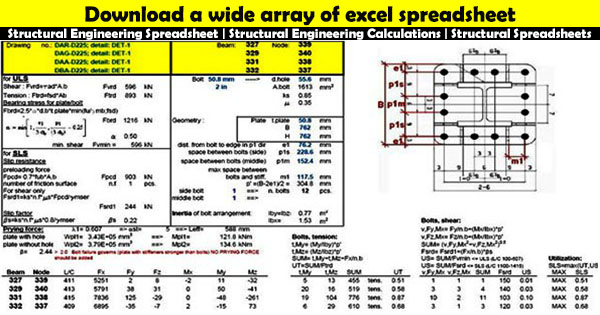

Overall, there are six different functions to find standard deviation in Excel.
#Excel formulas for civil engineering how to#
How to calculate standard deviation in Excel The key thing for you is to choose a proper standard deviation function, about which the following section will give you some clues. In Microsoft Excel, standard deviation is computed in the same way, but all of the above calculations are performed behind the scene. And you do this by using n - 1 instead of n, which is called Bessel's correction.įinally, take the square root of the above numbers, and you will get your standard deviation (in the below equations, rounded to 2 decimal places): Sample standard deviation Why this difference in the formulas? Because in the sample standard deviation formula, you need to correct the bias in the estimation of a sample mean instead of the true population mean. At this point, they are different.įor the sample standard deviation, you get the sample variance by dividing the total squared differences by the sample size minus 1:įor the population standard deviation, you find the mean of squared differences by dividing the total squared differences by their count: So far, the sample standard deviation and population standard deviation formulas have been identical. Divide the total squared differences by the count of values So, what we do now is add up the squared differences to complete this part of the formula: Σ( x i - x) 2Ĥ. To say "sum things up" in mathematics, you use sigma Σ. Then, you square the differences, turning them all into positive numbers: In this example, the mean is 5, so we calculate the difference between each data point and 5. To visualize what's actually going on, please have a look at the following images. This is the part of the standard deviation formula that says: ( x i - x) 2 For each number, subtract the mean and square the result To find mean in Excel, use the AVERAGE function, e.g. When calculating by hand, you add up the numbers and then divide the sum by the count of those numbers, like this: But first, let us have some sample data to work on:įirst, you find the mean of all values in the data set ( x in the formulas above). Having difficulties with understanding the formulas? Breaking them down into simple steps might help. n is the total number of x values in the data set.x i are individual values in the set of data.The reason the nature of the data matters is because the population standard deviation and sample standard deviation are calculated with slightly different formulas: Sample standard deviation Understanding the standard deviation formula Statisticians calculating the national SAT average score would use a sample standard deviation because they are presented with the data from a sample only, not from the entire population. For example, when summarizing the exam scores of a class of students, a teacher will use the population standard deviation. Researchers and analysists operate on the standard deviation of a sample and population in different situations. Sample is a subset of data that includes one or more elements from the population.Population includes all of the elements from a data set.In relation to standard deviation, you may often hear the terms "sample" and "population", which refer to the completeness of the data you are working with. In practice, the standard deviation is often used by business analysists as a measure of investment risk - the higher the standard deviation, the higher the volatility of the returns.

It shows that there is a huge dispersion (spread) in the scores, meaning that some students performed much better and/or some performed far worse than the average. Is that good? Well, yes, it indicates that the Biology scores of the students are pretty consistent.įor Math, the standard deviation is 23. To get a better idea of how this works, please have a look at the following data:įor Biology, the standard deviation is 5 (rounded to an integer), which tells us that the majority of scores are no more than 5 points away from the mean. The higher the standard deviation, the more variation there is in the data and the less accurate the mean is. The standard deviation equal to 0 indicates that every value in the dataset is exactly equal to the mean. The closer the standard deviation is to zero, the lower the data variability and the more reliable the mean is. The purpose of the standard deviation is to help you understand if the mean really returns a "typical" data. To put it differently, the standard deviation shows whether your data is close to the mean or fluctuates a lot. The standard deviation is a measure that indicates how much the values of the set of data deviate (spread out) from the mean.


 0 kommentar(er)
0 kommentar(er)
